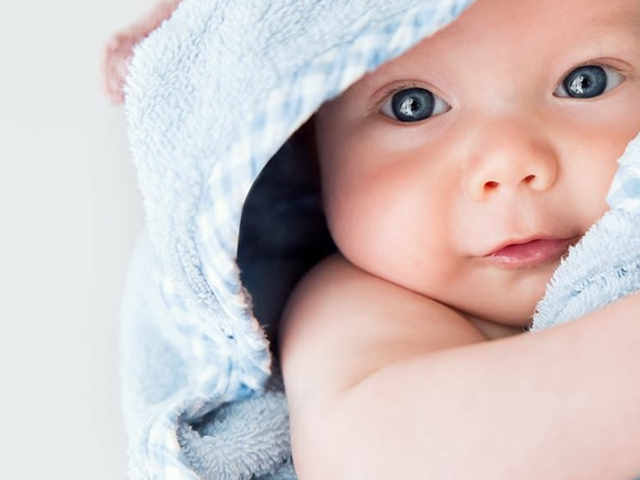
The skin
Babies' skin: As much as needed, as little as possible
Adults have a deep-seated instinct that makes them want to care for and protect babies and children. Even though your little one’s skin is still delicate and sensitive, there's no need to panic immediately about minor changes in the skin in the first few weeks after birth. In many cases, the skin is just learning. There are a wealth of skin care products available.
So far, we’ve focused on adults in our skincare cosmos. On the needs and wishes of grown-ups. But what we regard as our target group also includes babies and toddlers. Their skin also needs care and, like mom and dad, tailored personal care products are available to meet the requirements of their age group.
When it comes to skin care for children, it is not always a good idea to just reach for your own skincare products, i.e. products for adults. Because the saying "If it’s good enough for me, it's good enough for you" often does not apply in this context. But why is this?
To put it simply: not all skin is the same. Take a look at the products on offer. Products are available for a wide range of different skin and hair types. And babies and toddlers have skin that needs special attention – just because it is still very tender. And baby skin is still learning and adapting to a new environment. Their surroundings are have suddenly changed dramatically: From the moist environment of the uterus, to a relatively dry new environment. The skin needs time to get used to and adapt to this change.
The structure of the skin
When we look at ourselves or at others, we see their outer layer, the outer skin, also known as the epidermis, which also includes the important barrier layer, the stratum corneum. Underneath this is the dermis. The lowest layer is the subcutaneous tissue or hypodermis.
The skin is the outer shell protecting the body. It prevents the body from drying out. It works like a large sensor that allows us to detect the world around us.
Skin also includes skin appendages (adnexa) such as hair, sweat and sebaceous glands and nails, as they are also formed from the skin.
After birth, the physiological properties and associated capabilities of the skin are not yet fully present. It takes some time for the skin’s self-protection functions to fully develop and become the same as those in adult skin. In general, however, we can say that baby skin develops quite quickly, a lot is achieved even within the first month, and it is similar to adult skin after 1-2 years. As outlined in "Skin Barrier Function in Infants: Update and Outlook (nih.gov)", the differences between infant skin and adult skin are limited from a purely anatomical perspective. A thinner stratum corneum and the thinner epidermis are among the distinguishing features.
The pH value of the skin plays a major role in its development. Shortly after birth, infants have a neutral to slightly alkaline pH value on the surface of their skin. Normally, this value moves into the acidic range within the first month of life, which is important for the development of the skin barrier. Skin rashes and irritation can occur until the acid protective layer and the other defenses of the infant skin are strong enough.
Particularly around the bottom, when wearing diapers. The humid, warm climate created here, contact with feces and urine and constant friction causes damage to the skin. This can be counteracted by regularly changing diapers, washing with lukewarm water and ensuring that the skin is kept as dry as possible. Gently rubbing in special baby lotions can also protect the skin and relieve skin irritation and the itching it causes. Bacteria and fungi can also cause diaper rash. You should talk to your doctor about how best to treat this.
Skin in learning process
Another reason why baby skin is so sensitive is because the stratum corneum is much thinner than in adults. It is more permeable, allowing moisture to penetrate quickly, but also allowing it to drain out again more quickly, making it prone to dryness. Influences such as heat, cold, environmental factors can also increase sensitivity.
Red patches and occasionally peeling skin are therefore not unusual for little ones and are signs of the skin's learning or adaptation process. Typically, these stages are not a cause for concern, as the skin will "recover" on its own after a while. Because dry and possibly itchy skin is also unpleasant for babies, suitable creams should be used to provide relief.
If the symptoms persist, it is advisable to consult a pediatrician. He/she can quickly determine if treatment is needed, or if good care will be sufficient.
Why is a baby's skin more sensitive?
- Underdeveloped skin barrier functions (high transepidermal moisture loss)
- Undeveloped sebaceous and sweat glands
- Thinner stratum corneum + thinner epidermis
- Low level of surface lipids
- Underdeveloped temperature regulation
- Lack of natural UV protection due to a low proportion of melanin
Can babies sweat?
Yes. Although their sweat glands are not yet fully developed, they can still sweat. However, they are not yet able to regulate their own body temperature through sweating. This means that they are many times more prone to overheating than adults.
Proper care is therefore very important. For manufacturers, this means that they must develop specific formulations tailored to provide the best baby care, which need first and foremost to address the subject of "safety under conditions of use" as the most important claim. For this reason, particular care must be taken with the use of preservatives or fragrances containing known allergens, and similar. Important to know: Protection against microbial contamination is essential. Dermatological test series are typically used to confirm the mildness and tolerance of the products.
- Creams for distressed skin in the diaper area
- Baby bath products
- Shampoos
- Powders
- Baby wipes
- Skin oils
- Creams + lotions
- Sunscreen
One of the most prominent requirements for these products is the topic of skin moisturising or moisture uptake. As we outlined above: this does not necessarily apply in the diaper area due to the factors listed.
Prevention is also an important part of caring for a baby's skin. Avoid using too many unnecessary products and too frequent use of harmful products, and avoid direct sunlight. One thing is especially important to say here. You will often read that your baby or toddler is safe in the shade. However, this alone is not enough. Almost half of the UV radiation will penetrate the shade as deflected radiation. This is too much for sensitive baby skin. However, it should be taken into account that the strength of the reflection depends on the surface in question. The reflected portion of UV radiation is generally between 3–15%. However, snow can reflect up to 80–90% of UV rays (Ref.: „2018, Turner and Parsis. Ultraviolet Radiation Albedo and Reflectance in Review: The Influence to Ultraviolet Exposure in Occupational Settings.“). Always use suitable clothing, such as head coverings, as well as sun protection products suitable for infants.
At what age is a baby a baby and a child a child?
There is no generally accepted age range for defining childhood. Article 1 of the United Nations Convention on the Rights of the Child defines "children" as persons below the age of 18 years.
The National Association of Statutory Health Insurance Physicians in Berlin assigns names/terms to the various stages of childhood:
- Newborn until the age of 28 days
- Baby from the start of day 29 to the end of the 12th month
- Infant from the start of the 2nd year until the end of the 3rd year
- Child from the start of the 4th year up to the end of the 12th year
- Young person from the start of the 13th year up to the end of the 18th year
- Adult from the start of the 19th year
Baby Care – First Touch
Our baby care concept offers new formulations that have been specifically developed for sensitive baby skin, following the principle: “As little as possible, as much as necessary.” We choose carefully selected ingredients that are recommendable for the use on delicate baby skin. More informationIf you are wondering which product to choose next time you go shopping: look for products that match your age and skin type. Treat yourself to something good and your skin will appreciate it.


